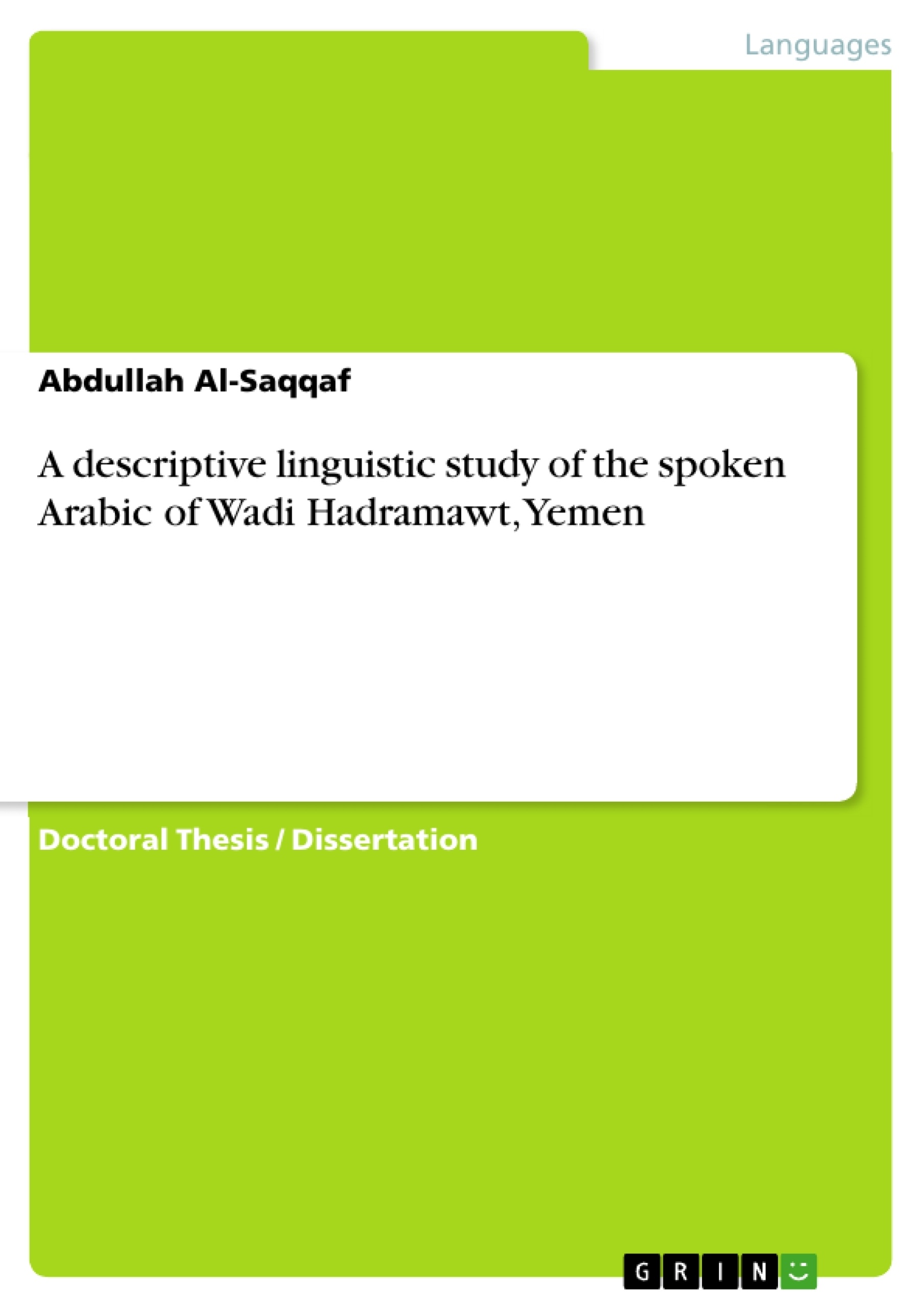This work begins with an introduction in which the area under investigation, Wādī Ḥaḍramawt is described, the dialect Ḥaḍramī Arabic (HA) is defined and previous work on HA is reviewed. In Chapter One the segmental phonology is dealt with by analysing the phonemic inventory of the dialect using three-term phonetic labels. Allophonic variants are also given at the end of each section and, where necessary, more phonetic details are given when comparing certain HA sounds with their counterparts in other Arabic dialects. Mention is also made of the sociolinguistic distribution of certain sounds peculiar to HA like the reflexes of <j>, <q>, <ḍ> and <đ̣>. The remainder of the chapter is on the prosody of the dialect including the effect of emphatic consonants on vowels, vowel harmony, syllable structure, stress, intonation and simplification.
Chapter Two is on the morphology of the dialect with verbal morphology in which verb patterns are discussed. These are transitive and intransitive verbs, comprising sound and weak verbs. Nominal morphology includes nouns derived from verbs, adjectives, pronouns, numbers etc. Also in this chapter, the main inflectional morpho-phonological processes are dealt with.
Chapter Three is concerned with the syntax of the dialect. Sentence types are dealt with, namely, nominal sentences, verbal sentences, equational sentences, complex sentences etc. Some particles peculiar to HA are dealt with and some of them are compared with their cognates in other dialects. Other sections include the passive, negation and co-reference in discourse.
Chapter Four is on vocabulary in which some lexical items of the dialect are dealt with, by reference to relations to other modern and old Arabic dialects, slang and neologism. Loan-words in HA are dealt with in some detail. The chapter ends with two lists of HA basic vocabulary in both Arabic and English entries. In Chapter Five there are transcripts, comments and translations of interviews recorded during fieldwork.
Inhaltsverzeichnis (Table of Contents)
- ABSTRACT
- ACKNOWLEDGEMENTS
- LIST OF ABBREVIATIONS
- LIST OF TRANSLITERATION SYMBOLS
- LIST OF TABLES
- MAP OF YEMEN
- MAP OF HADRAMAWT
- MAP OF WĀDĪ HADRAMAWT
- LINGUISTIC MAP OF THE SOUTHERN PARTS OF ARABIA
- INTRODUCTION
- 0.1 Preliminary
- 0.2 Area under investigation
- 0.3 Defining the dialect
- 0.4 The present linguistic situation
- 0.5 Previous Studies
- 0.6 The Present Study
- Notes
- CHAPTER 1: PHONOLOGY
- 1.0 Preliminary: The Sounds of HA
- 1.0.1 Consonants
- 1.0.2 Vowels
- 1.0.2.1 Monophthongs
- 1.0.2.2 HA vowel diphthongs
- 1.0.3 The transcription of final long vowels and consonants
- 1.1 Consonants in detail
- 1.1.1 Stops
- 1.1.1.1 The voiced bilabial stop b
- 1.1.1.2 The voiceless lamino-alveolar stop t
- 1.1.1.3 The voiceless lamino-alveolar emphatic plosive t
- 1.1.1.4 The voiced apico-alveolar stop d
- 1.1.1.5 The voiced palatal stop/affricate j
- 1.1.1.6 The voiceless velar stop k
- 1.1.1.7 The voiced velar stop g
- 1.1.1.8 The glottal stop
- 1.1.2 Fricatives
- 1.1.2.1 The voiceless labiodental fricative f
- 1.1.2.2 The voiceless interdental fricative t
- 1.1.2.3 The voiced inter-dental fricative d
- 1.1.2.4 The voiced interdental emphatic fricative d
- 1.1.2.5 The voiceless alveolar fricative s
- 1.1.2.6 The voiceless alveolar emphatic fricative s
- 1.1.2.7 The voiced alveolar fricative z
- 1.1.2.8 The voiceless palato-alveolar fricative š
- 1.1.2.9 The voiceless uvular fricative k
- 1.1.2.10 The voiced uvular fricative g
- 1.1.2.11 The voiceless pharyngeal fricative ḥ
- 1.1.2.12 The voiced pharyngeal fricative
- 1.1.2.13 The voiceless glottal fricative h
- 1.1.3 Nasals
- 1.1.3.1 The voiced bilabial nasal m
- 1.1.3.2 The voiced alveolar nasal n
- 1.1.4 The trill r
- 1.1.5 The laterals
- 1.1.5.1 The voiced alveolar lateral /
- 1.1.5.2 Voiced alveolar emphatic lateral /
- 1.1.6 Approximants
- 1.1.6.1 The voiced palatal approximant y
- 1.1.6.2 The voiced labiovelar approximant w
- 1.1.1 Stops
- 1.2 Vowels
- 1.2.1 Short vowels
- 1.2.1.1 i
- 1.2.1.2 a
- 1.2.1.3 u
- 1.2.1 Short vowels
- CHAPTER 2: MORPHOLOGY
- CHAPTER 3: SYNTAX
- CHAPTER 4: VOCABULARY
- CHAPTER 5: TRANSCRIPTS
Zielsetzung und Themenschwerpunkte (Objectives and Key Themes)
This thesis presents a descriptive linguistic study of the spoken Arabic of Wādī Haḍramawt, Yemen. It aims to provide a comprehensive analysis of the phonology, morphology, syntax, and vocabulary of the Ḥaḍramī Arabic dialect (HA). The study aims to contribute to the understanding of the linguistic diversity of Arabic and its regional variations.
- The phonological features of Ḥaḍramī Arabic
- The morphological patterns and processes of the dialect
- The syntactic structures and sentence types found in HA
- The lexical items and loanwords present in the dialect
- The sociolinguistic distribution of certain sounds in HA
Zusammenfassung der Kapitel (Chapter Summaries)
Chapter One focuses on the segmental phonology of Ḥaḍramī Arabic, analyzing the phonemic inventory and allophonic variations. It explores the sociolinguistic distribution of specific sounds unique to HA, like the reflexes of , <ḍ> and <ḍ>, as well as the prosody of the dialect.
Chapter Two delves into the morphology of the dialect, covering verbal morphology, including transitive and intransitive verbs, and nominal morphology, including nouns derived from verbs, adjectives, pronouns, and numbers. It also examines the main inflectional morphophonological processes.
Chapter Three explores the syntax of the dialect, analyzing sentence types, including nominal sentences, verbal sentences, and complex sentences. It discusses particles peculiar to HA and compares them with their cognates in other dialects. The chapter also covers the passive, negation, and co-reference in discourse.
Schlüsselwörter (Keywords)
Ḥaḍramī Arabic, Arabic dialects, phonology, morphology, syntax, vocabulary, Yemen, Wādī Haḍramawt, sociolinguistics, language variation, linguistic diversity, descriptive linguistics.
- Quote paper
- Abdullah Al-Saqqaf (Author), 1999, A descriptive linguistic study of the spoken Arabic of Wadi Hadramawt, Yemen, Munich, GRIN Verlag, https://www.grin.com/document/882658




